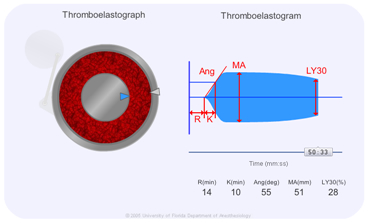
You must be a registered member to access this simulation. Registration is free and your privacy will be respected. If you are not already a member, click here to register. The thromboelastograph consists of two concentric cylinders with a space between them. The outer cylinder (cuvette) of the thromboelastograph oscillates at a fixed frequency. The internal cylinder (pin) of the thromboelastograph is free to move. As a blood sample placed between the cylinders clots, it forms a mechanical bond between the inner and outer cylinders of the thromboelastograph such that the oscillatory motion of the outer cylinder is imparted to the inner cylinder.A plot of the movement of the inner cylinder is known as a thromboelastogram. |
|
A stronger clot results in a tighter mechanical coupling between the two cylinders and a larger transmitted oscillation of the inner cylinder. Variation over time of the clot strength results in different thromboelastogram profiles that are useful for diagnosis. Feature extraction is applied to the resulting thromboelastogram to arrive at specific parameters such as R, K, Ang, MA and LY30. The thromboelastogram is used to diagnose different conditions such as fibrinolysis, thrombocytopaenia, and factor deficiency. |
|
